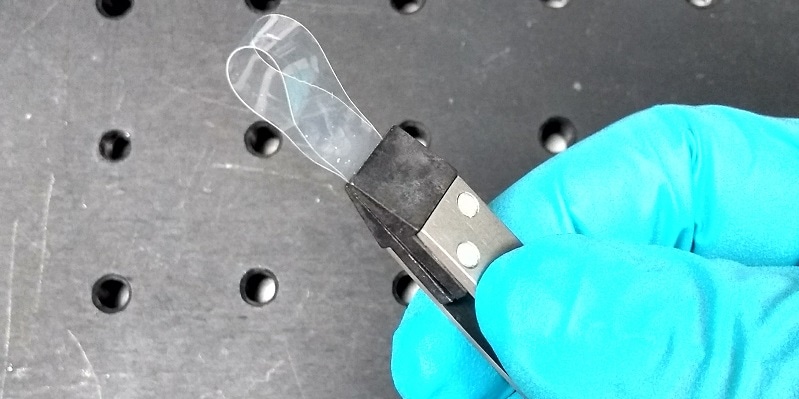Dec 5 2018
A research team at the University of Leeds has identified the first artificial material that thickens at the molecular level upon stretching. The researchers found that the novel, non-porous material exhibits special and inherent “auxetic” stretching characteristics.
 Liquid crystal elastomer with auxetic capabilities, showing its flexibility and high optical quality. (Image credit: Devesh Mistry)
Liquid crystal elastomer with auxetic capabilities, showing its flexibility and high optical quality. (Image credit: Devesh Mistry)
Materials existing in nature have auxetic capabilities—for example, cat skin, tendons in the human body, and the protective layer in mussel shells.
For over three decades, experts have been actively studying synthetic auxetic materials, but so far, they have only been able to produce them by structuring traditional materials through intricate engineering processes, such as 3D printing. However, such processes are not only costly and time-intensive but can also result in weaker, porous products.
Commercial applications
For materials scientists, physicists, and development companies, the identification of an artificial molecular version represents a significant step forward; however, scientists concede that additional studies have to be done to gain a more complete understanding of what exactly drives the auxetic behavior and how this behavior can be used at the commercial scale.
The study, headed by Dr Devesh Mistry from the School of Physics and Astronomy, has been reported in Nature Communications.
This is a really exciting discovery, which will have significant benefits in the future for the development of products with a wide range of applications. This new synthetic material is inherently auxetic on the molecular level and is therefore much simpler to fabricate and avoids the problems usually found with engineered products. But more research is needed to understand exactly how they can be used. When we stretch conventional materials, such as steel bars and rubber bands they become thinner. Auxetic materials on the other hand get thicker. Auxetics are also great at energy absorption and resisting fracture. There may be many potential applications for materials with these properties including body armour, architecture and medical equipment. We have already submitted a patent and are talking to industry about the next steps.
Dr Devesh Mistry, School of Physics and Astronomy, University of Leeds.
Expanding the potential of liquid crystals
The yet-to-be-named material was discovered by the researchers while they were inspecting the capabilities of liquid crystal elastomers. Best known for their applications in television and mobile phone screens, liquid crystals possess both solid and liquid properties. In addition, when liquid crystals are joined with polymer chains to develop rubbery networks, they gain completely new characteristics and hold many potential applications.
Our results demonstrate a new use for liquid crystals beyond the flat screen monitors and televisions many of us are familiar with. This new synthetic material is a great example of what physics research and exploring the potential of materials such as liquid crystals can discover. Collaboration between scientists with several areas of expertise and the extensive technical facilities we have at Leeds make this kind of exploration and discovery possible.
Helen Gleeson, Study Co-Author, Professor, and Head, School of Physics and Astronomy, University of Leeds.
Testing new materials
Thanks to the staff’s expertise and also the instruments available in the Leeds Electron Microscopy and Spectroscopy Centre (LEMAS) at the University, the team was able to stringently test the novel material.
We wanted to be sure the material wouldn’t break down or become porous when stretched to its limits. Our LEMAS centre had the tools to do this.
Helen Gleeson, Study Co-Author, Professor, and Head, School of Physics and Astronomy, University of Leeds.
LEMAS is a suite of state-of-the-art shared experimental facilities at the University of Leeds—also a part of the newly established Bragg Centre of Materials Research—available for use by universities and the industry.
One of the six areas of focus at the Bragg Centre is the study into soft matter, for example, liquid crystals.
At the Bragg Centre, engineers and scientists integrate applied science with scientific discovery in order to support the industry to design next-generation materials and thus enable innovative systems, devices, and applications.